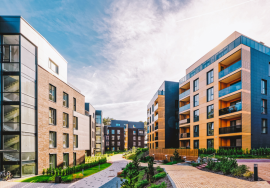Building Technologies for Smarter and Safer Homes
Building Technologies for Smarter and Safer Homes

In the ever-evolving world of real estate, the quest for smarter and safer homes is driving innovation in building technologies. With advancements in technology, modern homes are becoming increasingly intelligent, secure, and energy-efficient. This blog explores the latest building technologies that are enhancing the way we live, making homes smarter and safer than ever before.
The Rise of Smart Home Technologies
Smart home technologies have transformed the way we interact with our living spaces. From advanced security systems to intelligent climate control, these technologies offer unparalleled convenience and control, allowing homeowners to manage various aspects of their homes remotely.
Key Building Technologies Enhancing Smart Homes
1. Home Automation Systems
Home automation systems integrate various smart devices to create a cohesive and intelligent living environment. These systems enable homeowners to control lighting, heating, cooling, and security systems through a central hub or smartphone app. Automation can also include features like voice control, scheduling, and remote access.
- Example: Systems like Google Nest and Amazon Alexa allow homeowners to control their home environment with voice commands or mobile apps, making it easy to adjust settings from anywhere.
2. Advanced Security and Surveillance Systems
Security and surveillance technologies have come a long way, providing homeowners with robust solutions to protect their properties. Modern systems include smart locks, video doorbells, motion sensors, and surveillance cameras that can be monitored remotely. These technologies enhance home security by providing real-time alerts and video feeds.
- Example: Smart doorbells like Ring and Nest Hello offer video monitoring and two-way communication, allowing homeowners to see and interact with visitors at their doorstep remotely.

3. Intelligent Climate Control
Climate control systems have evolved to offer greater efficiency and comfort. Smart thermostats and climate control systems can learn homeowners’ preferences and adjust temperatures accordingly. They also enable remote access and control, allowing homeowners to manage their home’s climate from their smartphones.
- Example: The Nest Learning Thermostat adjusts temperature settings based on usage patterns and can be controlled remotely, helping homeowners save on energy costs and maintain a comfortable living environment.
4. Energy-Efficient Building Materials
Building materials that enhance energy efficiency play a crucial role in creating smarter homes. Advanced insulation materials, energy-efficient windows, and sustainable construction materials help reduce energy consumption and improve overall comfort. These materials contribute to lower utility bills and a smaller environmental footprint.
- Example: Low-E (low emissivity) windows help reduce heat transfer, improving insulation and energy efficiency by keeping homes warmer in the winter and cooler in the summer.
Benefits of Smart and Safe Building Technologies
5. Enhanced Security and Safety
Smart home technologies provide homeowners with greater control over their security and safety. With advanced surveillance systems and smart locks, homeowners can monitor their properties in real-time, receive instant alerts about potential security breaches, and manage access remotely. These features contribute to a safer living environment and peace of mind.
6. Improved Energy Efficiency
Energy-efficient building technologies and smart climate control systems help homeowners reduce their energy consumption and lower utility costs. By optimizing heating, cooling, and lighting based on real-time data and usage patterns, these technologies contribute to more sustainable and cost-effective living.
7. Increased Convenience and Comfort
Smart home technologies enhance convenience and comfort by automating various aspects of home management. From adjusting the thermostat to controlling lighting and security systems, homeowners can tailor their living environments to meet their preferences and needs. This increased control leads to a more enjoyable and comfortable living experience.
The Future of Building Technologies
8. Integration of Artificial Intelligence (AI)
Artificial Intelligence (AI) is set to play a significant role in the future of building technologies. AI-powered systems can analyze data from various sensors and devices to make predictive adjustments, optimize energy use, and enhance security measures. As AI technology advances, it will offer even greater capabilities for managing and improving smart homes.
- Example: AI algorithms can predict maintenance needs based on data from smart sensors, allowing homeowners to address potential issues before they become major problems.
9. Advanced Connectivity and IoT
The Internet of Things (IoT) is a key driver of innovation in smart homes. IoT enables devices and systems to communicate and interact with each other, creating a more interconnected and responsive living environment. Advanced connectivity will continue to enhance the functionality and integration of smart home technologies.
- Example: IoT-enabled devices like smart refrigerators and washing machines can communicate with home automation systems to provide updates, track usage, and optimize performance.
Conclusion
Innovative building technologies are transforming homes into smarter and safer living spaces. From advanced home automation systems to intelligent climate control and energy-efficient materials, these technologies offer numerous benefits, including enhanced security, improved energy efficiency, and increased convenience. As technology continues to evolve, the future of smart homes promises even greater advancements and capabilities.
For more information on integrating smart building technologies into your home, contact AMS India for expert advice and solutions. Additionally, explore the latest trends in smart home technologies at Smart Home USA.
Read more related articles to enhance your knowledge and make informed decisions
10 Essential Steps in the Building Construction Process
How to Choose the Right Materials for Your Construction Project








